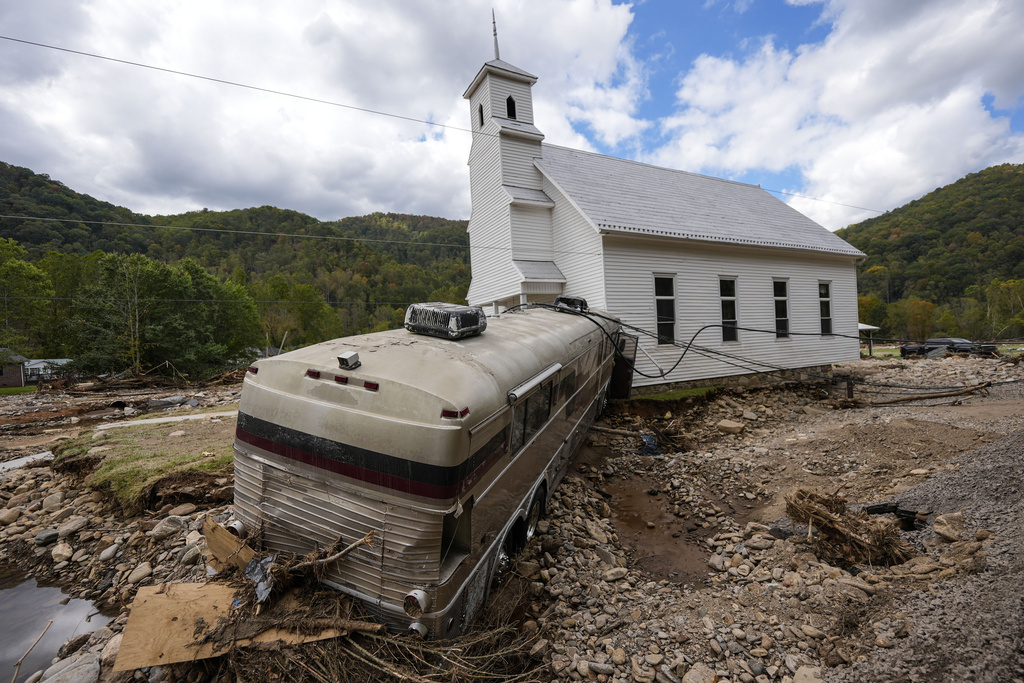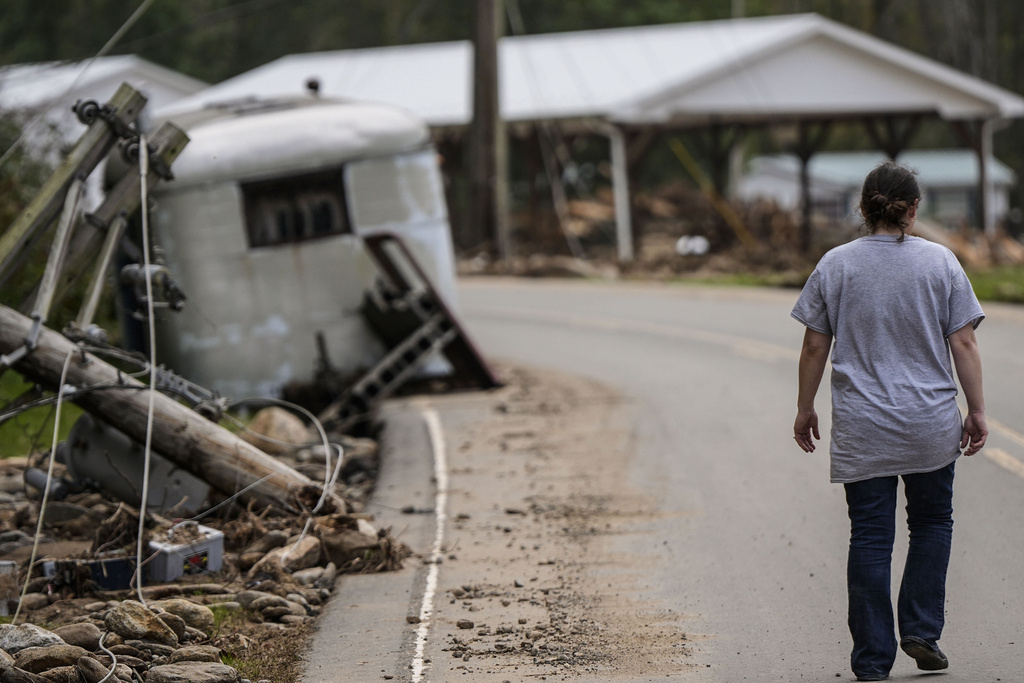Hurricane Helene Death Toll Reaches 200 Amid Search Efforts \ Newslooks \ Washington DC \ Mary Sidiqi \ Evening Edition \ Hurricane Helene’s death toll rose to 200, with rescue operations ongoing in hard-to-reach areas in western North Carolina. The storm’s destruction has left communities without electricity, water, and cellular service, and survivors are relying on each other for support. As federal and local aid efforts continue, the toll from the deadliest storm since Hurricane Katrina may yet rise.

Hurricane Helene’s Aftermath: Quick Looks
- Death Toll Reaches 200: Hurricane Helene has now claimed 200 lives, with search efforts ongoing in North Carolina’s mountainous regions.
- Community Support Amid Crisis: Survivors in affected areas, including Asheville and Black Mountain, lean on each other for food, water, and emotional support.
- Search and Rescue Efforts Continue: Helicopters and ground teams navigate debris-filled roads to locate survivors; power and water services are being slowly restored.
- Federal Response and Presidential Visit: President Joe Biden surveyed the damage and committed federal funding for debris removal and emergency measures in impacted states.
Deep Look
Hurricane Helene’s death toll surged to 200 on Thursday, and officials warn it could rise as searchers push deeper into the hardest-hit areas in the mountains of western North Carolina. The catastrophic storm, which made landfall in Florida before cutting a path of destruction through several southeastern states, has become the deadliest to hit the U.S. mainland since Hurricane Katrina in 2005.
In Georgia and North Carolina, authorities added more victims to their states’ tallies, continuing to piece together the storm’s grim impact. More than a week after Helene came ashore, the damage is immense, with entire communities cut off from basic services like electricity, water, and cellular coverage. In the midst of this chaos, survivors have found hope in small but powerful acts of connection—helping each other navigate the challenges they now face.
Government cargo planes carrying food and water have reached many of the storm-stricken areas, while rescue teams continue to comb through streams and creeks searching for missing persons. Amid the devastation, people have leaned on their neighbors and even strangers for support.
Sarah Vekasi, who runs Sarah Sunshine Pottery in Black Mountain, North Carolina, shared her struggles in the wake of Hurricane Helene. Her pottery business is uncertain, her future up in the air, but she expressed gratitude for surviving the disaster. “All I can say is that I’m alive. I’m not doing great. I’m not doing good. But I’m extremely grateful to be alive, especially when so many are not,” she said.
One bright spot for Vekasi has been gathering with her neighbors at the daily town meetings in the Black Mountain square. “It’s incredible being able to meet in person,” she said, recalling the sense of isolation that followed the storm when roads became impassable and she couldn’t reach out to others. More than 150 people joined Wednesday’s meeting, with local leaders standing atop a picnic table, shouting out updates on power restoration, road access, and water supplies.
One of those attending, Martha Sullivan, has lived in Black Mountain for over four decades. She took detailed notes during the meeting so she could share the information with others who could not attend. Despite the dangers and hardships following the storm, she declined her children’s invitation to relocate to Charlotte, opting instead to stay behind and support her neighbors. “I’m going to stay as long as I feel like I’m being useful,” Sullivan said.
In the most remote mountainous areas, helicopters worked tirelessly to rescue those left stranded, while crews cleared fallen trees to allow access to homes teetering on the edge of hillsides and washed-out riverbanks. Power restoration is happening slowly, with the number of homes and businesses without electricity dipping below 1 million for the first time since last weekend, according to poweroutage.us. Most outages are in North Carolina, South Carolina, and Georgia—areas that bore the brunt of Helene’s power after it made landfall on Florida’s Gulf Coast as a Category 4 hurricane.
The devastation also took its toll on Asheville, North Carolina, where resident Robin Wynn shared her story. Wynn lost power early on Friday morning and waded through knee-high floodwaters to reach a shelter. “I didn’t know where I was going, didn’t know what was going to happen next. But I got out and I’m alive,” Wynn said. Since returning home, Wynn’s community has rallied, with neighbors bringing hot meals and bottled water to one another.
Eric Williamson, a worker at First Baptist Church in Hendersonville, usually visits congregants who are physically unable to attend church. Now, he has become a lifeline, delivering food to meet dietary restrictions and clearing out spoiled items. Beyond providing food and water, Williamson emphasized the importance of human connection during times like this. “They don’t have telephone service, even if they have a landline, a lot of that isn’t working,” he said. “So we’re bringing them food and water, but also just bringing them a smile and a prayer with them, just to give them comfort.”
Volunteers in Asheville assembled on Wednesday before heading out to find people who had not been reachable since the storm. They carried boxes of drinking water and were instructed to return with updates on those they were able to find.
Communicating with the families of those who died in the storm has also proven challenging. Avril Pinder, an official in Buncombe County, where at least 61 people have died, described the difficulty of notifying next of kin amid communication breakdowns. “That has been our challenge, quite honestly, is no cell service, no way to reach out to next of kin,” Pinder said. She added that the county doesn’t yet have an official count of those who are unaccounted for or missing, as search and rescue operations entered their seventh day. “We’re continuing to find people. We know we have pockets of people who are isolated due to landslides and bridges out,” she noted. “So they are disconnected but not missing.”
On Thursday, President Joe Biden visited Keaton Beach, Florida, where he spoke with survivors, first responders, and local officials. He surveyed the storm’s destruction, walking past mountains of debris, destroyed homes, and splintered trees. Biden met with people who had lost everything, including one couple living out of a trailer near the remains of their house. The president also flew over parts of North and South Carolina on Wednesday to assess the broader impact.
The Biden administration has committed to covering the costs of debris removal and emergency response measures for six months in North Carolina and three months in Georgia. This funding is intended to help the states address issues like landslides, flooding, and the logistical needs of first responders, search teams, and shelters.
The storm’s impact reached Tennessee as well, where employees of a plastics factory in Erwin faced dire consequences after being kept at work until floodwaters had already become dangerous. The flooding swept 11 workers away, and while five were rescued, two have been confirmed dead. Tennessee authorities are investigating the company that owns the factory after allegations surfaced that management did not allow employees to leave early enough to avoid the flooding.
Hospitals across the Southeast have also struggled to cope with the storm’s aftermath. While most health facilities managed to stay open, many were forced to halt elective procedures due to blackouts, wind damage, supply disruptions, and localized flooding.
Florida officials have turned to a controversial solution to help clear the massive piles of debris left behind by Helene—using low-risk state prisoners. “Department of Corrections, they do prison labor anyways. So they’re bringing them to do debris removal,” Florida Governor Ron DeSantis said, confirming that inmates would be involved in the cleanup effort.
As the recovery continues, the death toll of 200 is a sobering reminder of Hurricane Helene’s destruction. Survivors and rescuers alike face difficult conditions as they work to restore a sense of normalcy to communities still reeling from the storm. While federal aid, rescue teams, and government coordination are essential, the human connections that have emerged in the hardest-hit places have provided a critical lifeline for many. These bonds, forged in crisis, have allowed communities to hold on to hope as they navigate an uncertain future.
Hurricane Helene Death Hurricane Helene Death Hurricane Helene Death







